By Contributing Editor Brendan Mackie
Just what makes humanity special? On a range of merely physical indicators, the human animal is downright average. Our metabolic rate is roughly what it is for other animals our size. We’re decent sprinters, but not particularly strong. Darwin said that the difference between the human and . And although we’re clearly smart, who knows how smart we would find a sperm whale to be, if we could only speak whale?
One indicator does set humanity apart.While every other mammal gets roughly a billion heartbeats over their natural lifetime, a modern human gets more than two and a half billion beats. Why?
A pair of recently released books looks to answer the question by looking at the geometry of human social life. In Scale (Penguin Random House, 2018), Geoffrey West, a theoretical physicist and long-time head of the Santa Fe Institute, explores what happens when things get big and small. It turns out that things from animals to trees to cities scale in very similar ways because of the special geometric properties of fractal networks. The secret to our extra billion beats lies in the scaling properties of modern life. Niall Ferguson’s The Square and the Tower (Penguin, 2018) argues that the big creative moments of your World History survey class like the Industrial Revolution can be explained by the shape of historical social networks. Two stand out: the network, and the hierarchy. Both books present easy to understand, compelling stories about what make humans—particularly modern humans—different. Both books agree that this difference resides in the geometry of human connection.
Scale makes one big point. As a number of things (animals, trees, cities, companies) get bigger, they get bigger in similar ways. Bigger animals, for instance, have lower metabolic rates because each individual cell needs to work less; this means a slower heartbeat, and a longer life span. For every four orders of magnitude an animal grows, its metabolic rate only grows three orders of magnitude. This is true for the 27 orders of magnitude of life on earth, from bacteria to whales. There are similar scaling patterns for scores of indicators, from the width of tree trunks to the size of the aorta.
[youtube https://www.youtube.com/watch?v=foxD6ZQlnlU&w=560&h=315]
The reason for these roughly similar scaling relationships in so many different domains is that we are dealing with same kind of shape: space-saving self-similar fractal networks. A : a coastline, a tree, a lung, an org chart, a paisley pattern. Fractals have a special property that they seem to grow the more you zoom in on them. You know this intuitively. Imagine measuring the coastline of California from one of those big elementary school atlases. Then imagine measuring the same coastline on foot with a ruler, walking patiently along every cliff, every inlet, and every tide pool. The second measure would be far longer than the first, because you’d be picking up on the coastline’s fractal dimension—the little zigs and zags that are only appreciable when you get really close to them. This means fractals behave as if they have an extra dimension. Take the little fractal bags of air called alveoli that fill up our lungs. If you unfurled them, their surface area could cover a tennis court, although they only take up five liters of space in your chest. This extremely fast scaling is why fractals appear so much in nature—they are incredibly efficient at filling up valuable space, and so are continually selected for.
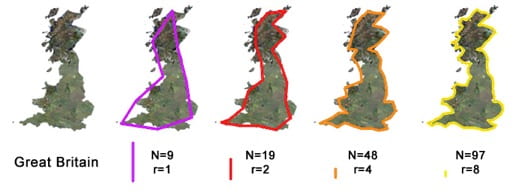
From the Fractal Foundation’s course on the Fractal Dimension
But this does not account for our extra billion heartbeats. To do so, West pushes us to see humanity as something more than just the sum of our biological processes. Look at just how much energy we use in a day. Our bodies use only slightly more energy than a 90 Watt lightbulb. But accounting for our extra-bodily energy use (the fertilizer used to grow our crops, the gasoline used to drive our cars, the electricity we use to run our computers) we use more like 11,000 watts a day—the equivalent of a small group of elephants. We have an extra billion heart beats because we are effectively much larger and greedier animals than our physical size would suggest. Here’s West summing it up: “Our effective metabolic rate is now one hundred times greater than what it was when we were truly biological animals, and this has had huge consequences for our recent life history. We take longer to mature, we have fewer offspring, and we live longer, all in qualitative agreement with having an effectively larger metabolic rate arising from socioeconomic activity.” We should consider the modern human not an animal, but as an animal at the center of a massive networks of buildings, machines, roads, businesses, and institutions. These are why we have the extra billion heart beats.
New York by Reddit user CitrusVanilla https://www.reddit.com/r/dataisbeautiful/comments/8hys9k/the_city_is_alive_the_population_of_manhattan/
That massive networks of buildings, machines, roads and institutions go by another name—the city—and it is in West’s discussion of the modern city that he comes closest to explaining the history of human divergence. It will be no surprise that there are robust scaling relationships tourban phenomena as well. We can appreciate this in a pair of logarithmic graphs. As a city gets an order of magnitude bigger,its infrastructure (the length of its roads and power lines, the number of its gas stations) increases by 0.85 of an order of magnitude;while its ‘socioeconomic effects’ (income, flu and crime rates, patents filed, number of restaurants) increase by 1.15 orders of magnitude. This might not seem like a big difference, but it compounds exponentially. Bigger cities become cheaper and cheaper to provision per person, and similarly they become increasingly creative, wild, interesting, varied, and profitable. It is not liberal institutions, or the special genius of a particular culture, or democracy that have led to the prosperity of the modern world. It’s the metropolis.
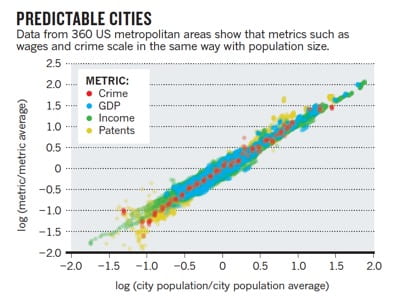
From A Unified Theory of Urban Living by Luis Bettencourt. Note the scale is logarithmic.
Has this always been the case? Will it continue? As for the future, West is softly apocalyptic. Exponential growth—that is, a phenomenon in which the rate of growth is itself growing—must always reach a limit. The past two-hundred years have been an outlier, because new innovations have effectively reset the growth curve before this limit has been reached. When steam engine spluttered out, along came steel. Big data might soon reach its peak, but within a year or two we’ll have AI. But as the growth curve gets ever steeper, the extra time bought by each subsequent innovation is a little bit less, so the new innovation must come ever quicker—until we can buy no more time at all.
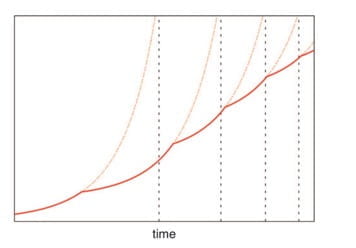
A schematic of the increasing pace of innovation, from Growth, Innovation, Scaling and the Pace of Life In Cities, by Bettencourt, et. al.
The implications that these scaling patterns have for our understanding of the past is another matter. It is an unanswered question whether the same relationships existed for cities before the modern era (there is some indication that they do). Yet I suspect that before the prevalence of cheap energy from fossil fuels, big cities were simply too dirty, too complicated, and too messy to sustain major growth. Historians could do interesting work seeing how the scaling relationships in human societies have changed over time.
West, a physicist, looks for elegant, parsimonious answers to big questions. But he only gets this perspective by stripping away particularities until all that’s left is a piece of data that can be pinned on a graph. There is little room for the individual in West’s story—even the scientists, entrepreneurs, politicians and kings that are the usual protagonists of doorstopper history books. There can be little confrontation with inequality in West’s story, because studying inequality means wrestling with difference, and difference here is stripped away in favor of the big picture. Why do some people grow rich and others stay poor? Why do some societies decline, while others come to a kind of supremacy? Does exponentially growing prosperity simply make a small group of people obscenely rich? Is this all good? Or is it bad? In the end, West can show us the pattern, but he cannot tell us the meaning of the pattern, because we’ve zoomed so far out the human has foreshortened to almost nothing.
One way of capturing the dynamics of scale while keeping attention on the human is to look at networks. It is the properties of fractal networks after all that give modern cities their peculiar scaling properties. Niall Ferguson attempts such a history in his recent book The Square and the Tower. Ferguson is a self-professed ‘network guy’; a man of dinner parties, conferences, and wide-ranging influence. (Ferguson even appears in West’s acknowledgements.) Ferguson, like West, sees humanity as a species defined by its participation in networks—he even suggests that humanity might be renamed homo dictyous, or Network Man. And like West, Ferguson proffers a parsimonious explanation for the modern world, in which modernity is driven by the special properties of social networks. Ferguson’s idea is that history is driven by the For most of human history, hierarchies reigned. But during certain periods, networks successfully challenged hierarchies, leading to amazing ages of human potential
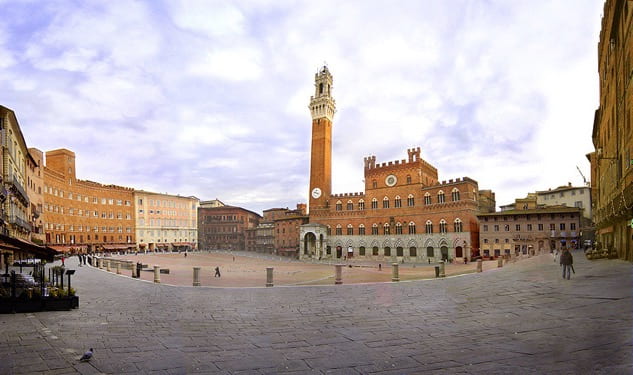
The Square and the Tower of the title, from Siena, from Wikipedia
Two moments stand out. The first happened in Western Europe between the Commercial and Industrial Revolutions. Unconstrained by a strong despotic state, European men formed networks with relative freedom. Networks of sailors benefiting from the competitive patronage of Mediterranean princes traded information about trade routes and sea winds, allowing them to ride the waves of the Atlantic and exploit the Americas. The printing press allowed the creation of networks of print that spread the message of Martin Luther (but came too late to spread the equally revolutionary words of Jan Hus), unintentionally upending restrictive religious orthodoxies. Networks of scientists and tinkerers were allowed to build up knowledge of the solar system and steam engines without worrying about the hierarchy of the Inquisition restricting their inquiries. Networks of malcontents and revolutionaries egged each other on to mount the American and then the French Revolutions. But in history there must be a fall for every rise: in the 19th century hierarchies reestablished themselves—here comes Napoleon on his world historical horse, an Emperor to rip the networks of the Sans Culottes to shreds. In the aftermath of Waterloo, European nations created an unequal hierarchical world order. Big businesses expanded with top-heavy org charts. More war! 1914! 1945! Networks only rose again this past generation, prompting computers, the internet, Twitter, and the usual list of salutary or not so salutary developments. (Al Qaeda, though it means “The Base,” is a network.)
The simplicity of West’s story is grounded in precise mathematical definitions, but Ferguson’s simplicity rests on concepts that never really get firmly pinned down. It’s unclear, frankly, just what Ferguson means by network and hierarchy. Ferguson gives no end of examples: hierarchies are horizontal, while networks are vertical; hierarchies give people power, networks influence; hierarchies are kings and CEOs, networks influencers and creatives; hierarchies are bureaucratic organizations, networks loose alliances. Hierarchies are the Mughal Court, the Pentagon, the Aztecs, and the office of the Presidency. Networks are the East India Company, spy rings, the Royal Society, the conquistadors, and the friends of Henry Kissinger. In a central chapter, Ferguson proposes a formal definition from network analysis that a hierarchy is a special kind of self-similar network in which connections are monopolized by particular nodes. But this formal definition is rarely if ever mobilized to actually define whether a given organization is a network or a hierarchy. Instead if it looks like a network, then it’s a network. If it looks like a hierarchy, then it’s a hierarchy. Oddly enough for a book in which network analysis is meant to uncover new patterns in history, we hardly ever look into the geometry of the historical networks themselves. Instead we get a long string of anecdotes.
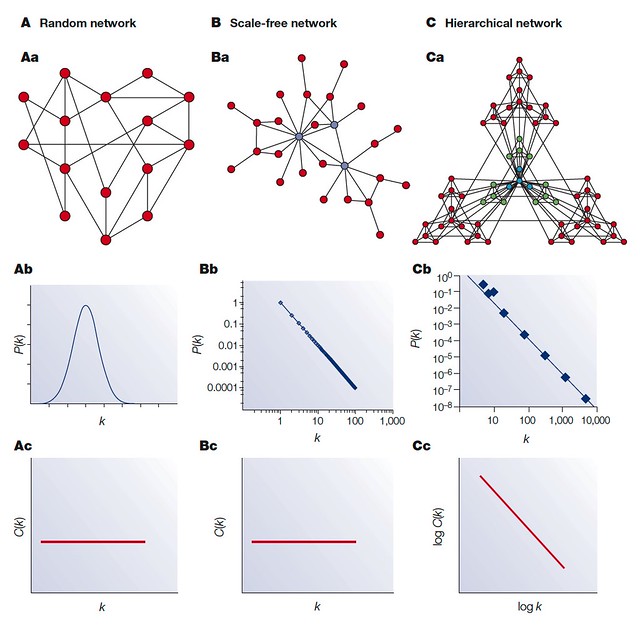
What is clear is that a previously-obscured historical actor is now uncertainly stepping to the forefront of the human drama—the network—and history has to grapple with it. But what are we to do? How can we tell historical stories using these new tools but still pay attention to individuals and difference? We are left with a series of itching inconclusive questions: How are we all connected? How can we reach beyond the dull confusion of our small lives to somehow understand the universe itself? And not to forget that there are people in those dots, love and enmity in those lines connecting them?



1 Pingback